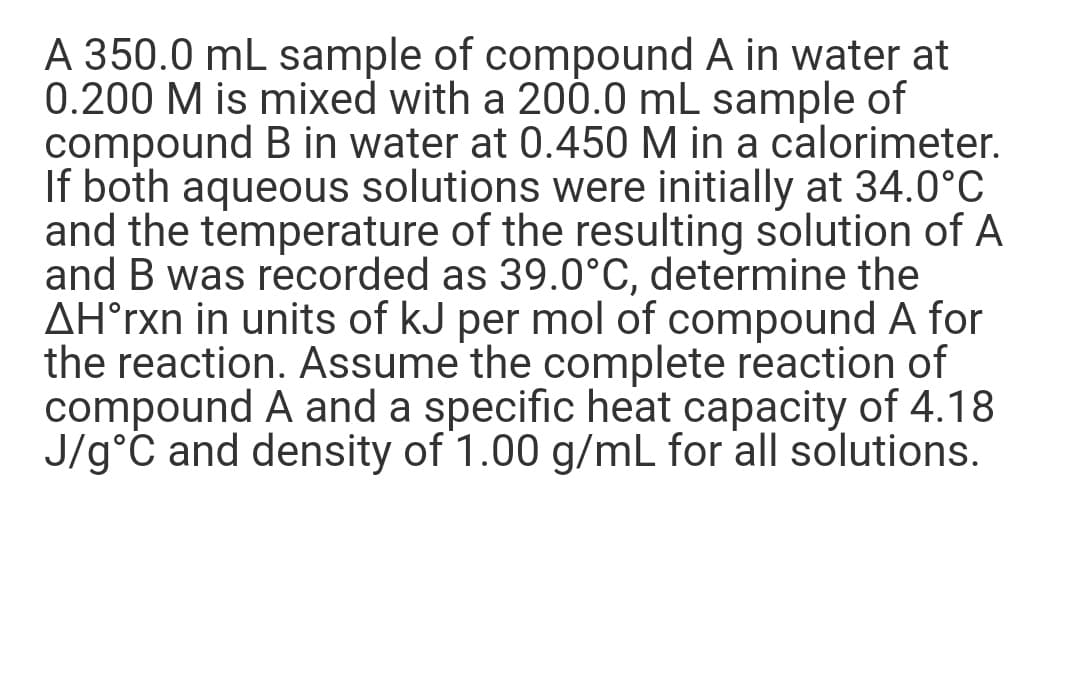A 350.0 mL sample of compound A in water at 0.200 M is mixed with a 200.0 mL sample of compound B in water at 0.450 M in a calorimeter. If both aqueous solutions were initially at 34.0°C and the temperature of the resulting solution of A and B was recorded as 39.0°C, determine the AH°rxn in units of kJ per mol of compound A for the reaction. Assume the complete reaction of compound A and a specific heat capacity of 4.18 J/g°C and density of 1.00 g/mL for all solutions.
A 350.0 mL sample of compound A in water at 0.200 M is mixed with a 200.0 mL sample of compound B in water at 0.450 M in a calorimeter. If both aqueous solutions were initially at 34.0°C and the temperature of the resulting solution of A and B was recorded as 39.0°C, determine the AH°rxn in units of kJ per mol of compound A for the reaction. Assume the complete reaction of compound A and a specific heat capacity of 4.18 J/g°C and density of 1.00 g/mL for all solutions.
Introduction to Chemical Engineering Thermodynamics
8th Edition
ISBN:9781259696527
Author:J.M. Smith Termodinamica en ingenieria quimica, Hendrick C Van Ness, Michael Abbott, Mark Swihart
Publisher:J.M. Smith Termodinamica en ingenieria quimica, Hendrick C Van Ness, Michael Abbott, Mark Swihart
Chapter1: Introduction
Section: Chapter Questions
Problem 1.1P
Related questions
Question

Transcribed Image Text:A 350.0 mL sample of compound A in water at
0.200 M is mixed with a 200.0 mL sample of
compound B in water at 0.450 M in a calorimeter.
If both aqueous solutions were initially at 34.0°C
and the temperature of the resulting solution of A
and B was recorded as 39.0°C, determine the
AH°rxn in units of kJ per mol of compound A for
the reaction. Assume the complete reaction of
compound A and a specific heat capacity of 4.18
J/g°C and density of 1.00 g/mL for all solutions.
Expert Solution
This question has been solved!
Explore an expertly crafted, step-by-step solution for a thorough understanding of key concepts.
This is a popular solution!
Trending now
This is a popular solution!
Step by step
Solved in 4 steps

Knowledge Booster
Learn more about
Need a deep-dive on the concept behind this application? Look no further. Learn more about this topic, chemical-engineering and related others by exploring similar questions and additional content below.Recommended textbooks for you

Introduction to Chemical Engineering Thermodynami…
Chemical Engineering
ISBN:
9781259696527
Author:
J.M. Smith Termodinamica en ingenieria quimica, Hendrick C Van Ness, Michael Abbott, Mark Swihart
Publisher:
McGraw-Hill Education

Elementary Principles of Chemical Processes, Bind…
Chemical Engineering
ISBN:
9781118431221
Author:
Richard M. Felder, Ronald W. Rousseau, Lisa G. Bullard
Publisher:
WILEY

Elements of Chemical Reaction Engineering (5th Ed…
Chemical Engineering
ISBN:
9780133887518
Author:
H. Scott Fogler
Publisher:
Prentice Hall

Introduction to Chemical Engineering Thermodynami…
Chemical Engineering
ISBN:
9781259696527
Author:
J.M. Smith Termodinamica en ingenieria quimica, Hendrick C Van Ness, Michael Abbott, Mark Swihart
Publisher:
McGraw-Hill Education

Elementary Principles of Chemical Processes, Bind…
Chemical Engineering
ISBN:
9781118431221
Author:
Richard M. Felder, Ronald W. Rousseau, Lisa G. Bullard
Publisher:
WILEY

Elements of Chemical Reaction Engineering (5th Ed…
Chemical Engineering
ISBN:
9780133887518
Author:
H. Scott Fogler
Publisher:
Prentice Hall


Industrial Plastics: Theory and Applications
Chemical Engineering
ISBN:
9781285061238
Author:
Lokensgard, Erik
Publisher:
Delmar Cengage Learning

Unit Operations of Chemical Engineering
Chemical Engineering
ISBN:
9780072848236
Author:
Warren McCabe, Julian C. Smith, Peter Harriott
Publisher:
McGraw-Hill Companies, The